Heritage in Danger: Digital Conservation and a Reserve for the Future of the Benzú Rock Shelter and Cave (Ceuta, Spain)
Abstract
1. Introduction
- -
- Quaternary geology (geomorphology and stratigraphy).
- -
- Archaeologically, ten strata were documented, seven of which yielded evidence of human activity during prehistory, although the natural cementation processes undergone by the sediments made excavation a daunting task [24,25]. The historical chronological sequence of the strata was established by means of absolute dating techniques (OSL, TL, U/Th, and C14).
- -
- Ecological reconstruction of the Pleistocene and Holocene environment; terrestrial fauna; marine fauna; birds; and plants (pollen, seed, anthracological, and phytolith analysis). This aimed to establish the relationship of human societies and their environment.
- -
- Origin and characterisation of the lithic raw materials used in the Benzú rock shelter and cave [20]. This is key for understanding resource supply systems and group mobility patterns.
- -
- -
- Revision of traditional prehistoric narratives, taking a view from the south of the human colonisation of Europe during prehistory and the possible links between the two shores of the Strait of Gibraltar.
- -
- Review of the chronology of the Mode 3-Middle Palaeolithic, which has shown to be earlier than previously thought (300 Ka.).
- -
- Confirmation of the importance of marine resources for hunter-gatherers (over 150,000 years ago) [22].
- -
- Research at Benzú cavehas led to major new insights into the beginnings and developments of productive economic strategies. Two occupation horizons dated to the Early Neolithic and the Bronze Age were defined, probably in relation to the use of the cave as a shelter by shepherds and as a burial site, respectively [26].
- -
- Geostrategic importance of the geohistorical region of the Strait of Gibraltar.
2. Location, Natural Environment, and Geology
3. Conservation Issues: Historical Evolution of the Archaeology of the Mogote de Benzú
4. Digital Theoretical Framework
5. Material and Methods
- -
- A Nikon D3100 with 14 MP, equipped with an 18–55 mm lens (Manufactured by Nikon Corporation, Tokyo, Japan).
- -
- A high-speed Leica RTC360 laser scanner (Manufactured by Leica Geosystem, Heerbrugg, Switzerland) with an integrated HDR spherical imaging system and visual inertial system (VIS) for real-time registration. It features automatic object removal with its double-scan function. The scanner has a 360° horizontal and 300° vertical field-of-view, with a range of up to 130 metres and the ability to record up to 2,000,000 points per second. Remote control of the functions is available via a mobile device using Leica Cyclone Field 360 software (v. 2025.0.0), which allows real-time 2D and 3D data visualisation and automatic scan alignment.
- -
- An iPad Pro (Manufactured by Apple, Cupertino, CA, USA).
- -
- A Leica GS18T GNSS RTK (Manufactured by Leica Geosystem, Switzerland), which combines GNSS and IMU (tilt compensation), connected to multiple constellations to receive real-time corrections.
- -
- Additionally, different software applications were used for the processing phase, each tailored to its respective method before combining the data. For photogrammetric processing, Agisoft Metashape 1.8 was used, while Leica Register 360 and Leica 3DR (v. 2021.0) were employed for 3D scanning. These software applications were installed on a high-performance computing system comprising an Intel i7 8700 4.6 GHz 8-core processor, 64 GB of RAM, and an 8 GB AMD Radeon GPU.
5.1. Fieldwork
5.1.1. The Recording of Benzú Rock Shelter
5.1.2. The Recording of Benzú Cave
5.2. Laboratory Work
5.2.1. Postprocessing of Data from Benzú Rock Shelter
- Alignment. The software detects key points in the photographs (stereo couples) to calculate the position of the camera. This first step generates a disperse cloud that presents a preliminary image of the 3D model.
- Dense point cloud. This point cloud is denser and allows for corrections, including the filtering of points according to confidence. This allows for the assessment of the quality of the 3D model generated, and the greater the confidence level, the more accurately the model represents reality.
- Generation of the mesh, which is a 3D geometric model. This model is composed of vertexes (points), edges (unions between points), and polygons (the face formed by linking two or more points in a closed circuit). The model allows for full-colour previsualisation.
- Texturing. This process lays an image over the mesh, adding the colours calculated based on the key points to give the final 3D model a photorealistic finish.
5.2.2. Postprocessing of Data from Benzú Cave
6. Results. Virtualisation as a Digital Conservation Model
6.1. Benzú Rock Shelter
6.2. Benzú Cave
7. Discussion
7.1. Technical Aspects of This Methodology
7.2. Research and Conservation Plan
7.3. Heritage Enhancement Proposal
8. Conclusions
Author Contributions
Funding
Institutional Review Board Statement
Informed Consent Statement
Data Availability Statement
Acknowledgments
Conflicts of Interest
Appendix A
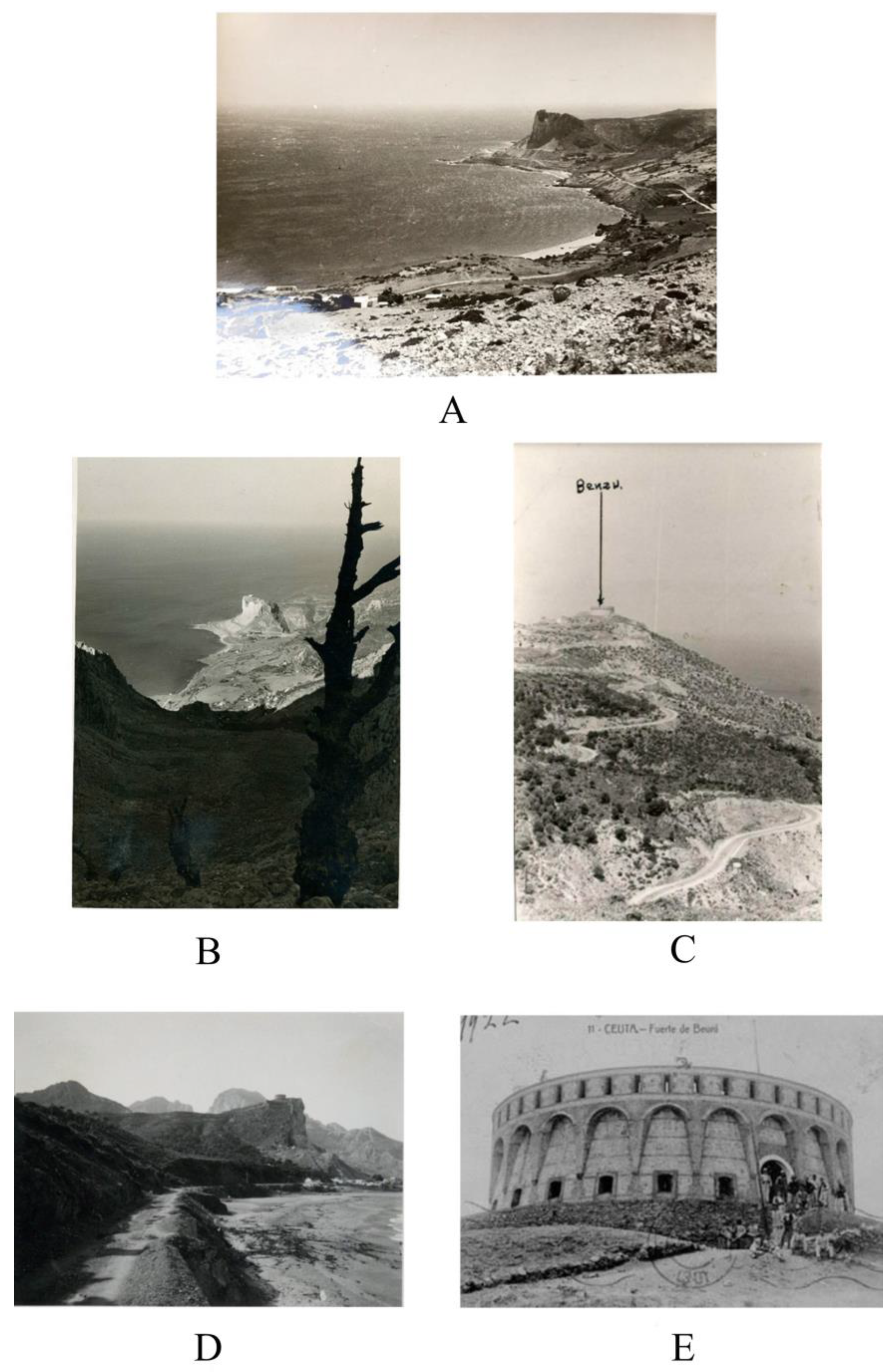
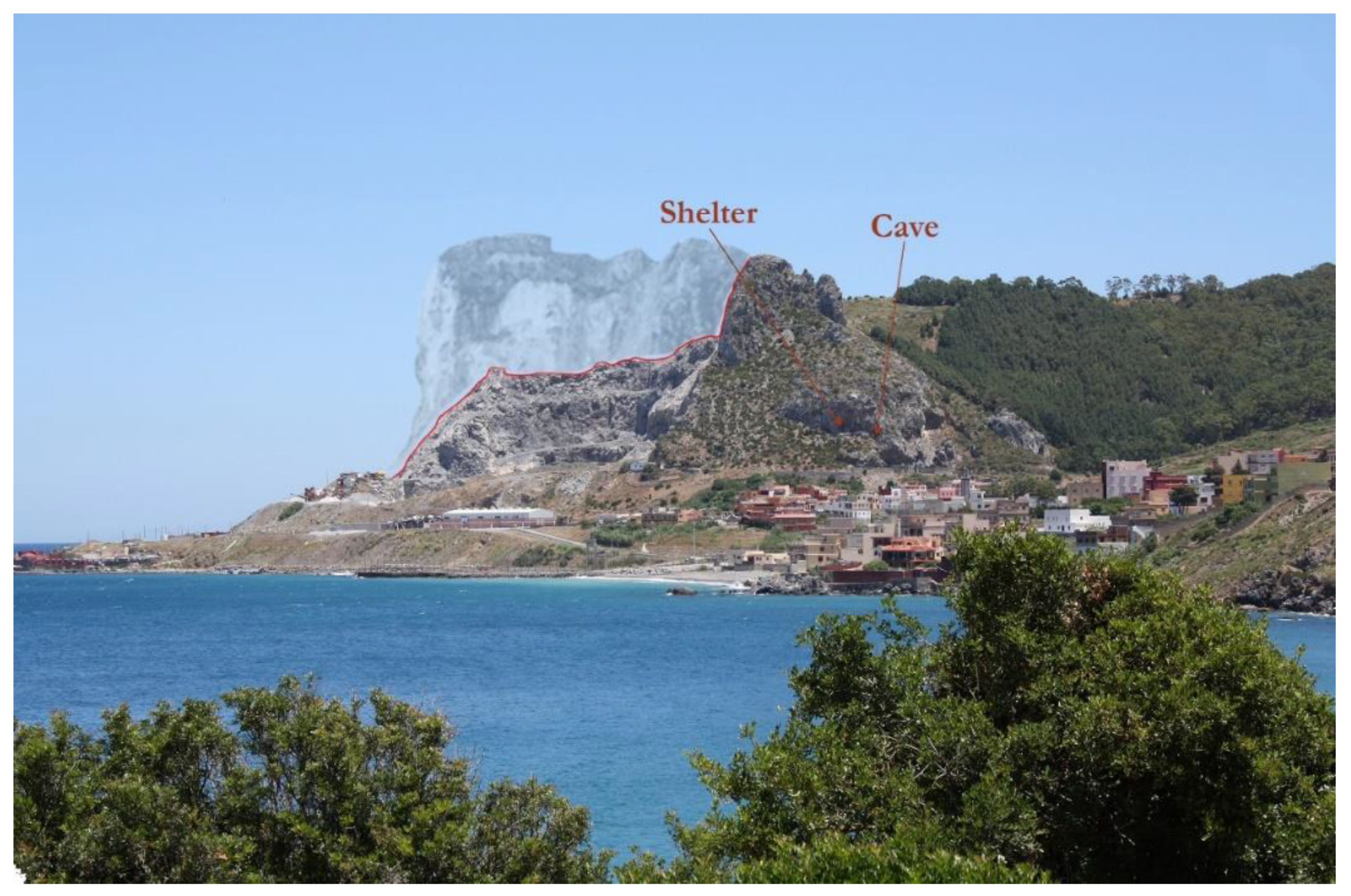
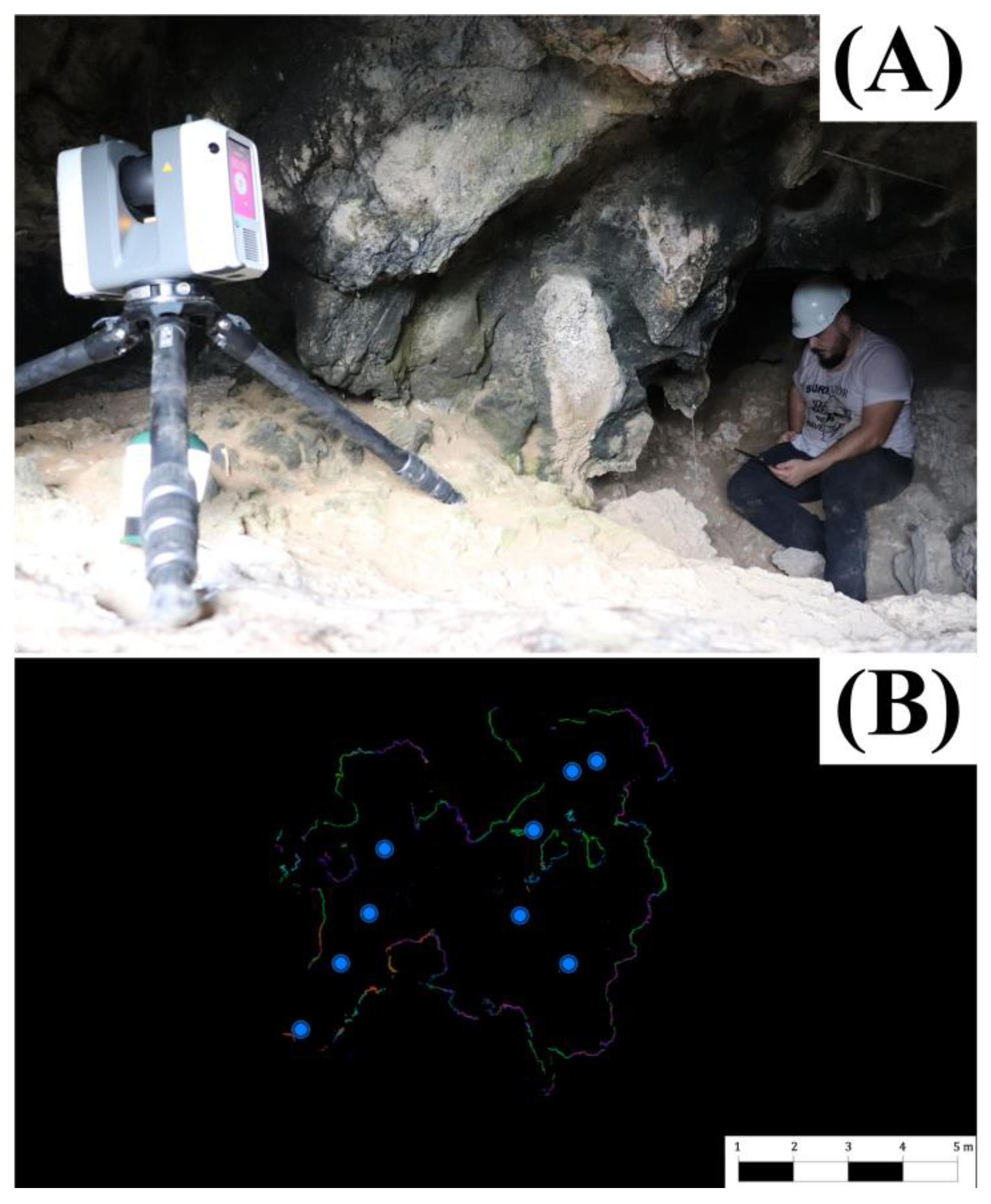
References
- Burillo Mozota, F.; González, I.; Polo Cutando, C. El Patrimonio arqueológico en el medio rural. In Cuadernos Conservación Arqueologica. Reflexión y Debate Sobre Teoría y Práctica; Instituto Andaluz del Patrimonio Histórico: Seville, Spain, 2014; pp. 36–49. [Google Scholar]
- Boado, F.C. El futuro de la Arqueología, ¿la Arqueología del futuro? Trab. de Prehist. 1996, 53, 15–35. [Google Scholar] [CrossRef]
- Ballart, J. El Patrimonio Histórico y Arqueológico: Valor y Uso; Ariel Patrimonio Histórico: Barcelona, Spain, 1997. [Google Scholar]
- Ruiz Zapatero, I. Fragmentos del pasado: La presentación de sitios arqueológicos y la función social de la Arqueología. Treballas D’arqueologia 1998, 5, 7–33. [Google Scholar]
- García Pazos, M.; Cirici Narváez, J.R. (Eds.) Las tribulaciones en la tutela del Pagtrimonio paisajístico y urbano. In Serie Encuentros de Primavera en El Puerto 4; Ayuntamiento de El Puerto de Santa María: Cádiz, Spain, 2001. [Google Scholar]
- Rodríguez Temiño, I. Arqueología Urbana en España; Ariel Patrimonio: Barcelona, Spain, 2003. [Google Scholar]
- Pastoors, A.; Weniger, G.-C. Cave Art in Context: Methods for the Analysis of the Spatial Organization of Cave Sites. J. Archaeol. Res. 2011, 19, 377–400. [Google Scholar] [CrossRef]
- Gándara, M. Algunas notas sobre el análisis del conocimiento. Boletín De Antropol. Am. 1994, 22, 5–19. [Google Scholar]
- Bate, L.F. El Proceso de Investigación en Arqueología; Crítica: Barcelona, Spain, 1998. [Google Scholar]
- Vargas, I. La identidad cultural y el uso social del patrimonio histórico. El caso de Venezuela. Boletín Del Inst. Del Patrim. Histórico 1997, 2, 82–86. [Google Scholar] [CrossRef]
- Espejo Herrerías, M.M.; Ramos Muñoz, J.; Cantalejo Duarte, P. Prehistoria en el entorno de Caminito del Rey. In Ruta Por Los Orígenes de Málaga; ArdalesTur Ediciones: Málaga, Spain, 2022. [Google Scholar]
- Cantalejo Duarte, P.; Ramos Muñoz, J.; Weniger, G.-C.; Espejo Herrerías, M.M. Cueva de Ardales. In Cuadernos de Divulgación Científica; Junta de Andalucía: Sevilla, Spain, 2021. [Google Scholar]
- Hoffmann, D.L.; Standish, C.D.; García-Diez, M.; Pettitt, P.B.; Milton, J.A.; Zilhão, J.; Alcolea-González, J.J.; Cantalejo-Duarte, P.; Collado, H.; de Balbín, R.; et al. U-Th dating of carbonate crusts reveals Neandertal origin of Iberian cave art. Science 2018, 359, 912–915. [Google Scholar] [CrossRef]
- Zouak, M.; Vijande-Vila, E.; Cantillo-Duarte, J.J.; Domínguez-Bella, S.; Maate, A.; Cantalejo Duarte, P.; Moreno-Márquez, A.; El Idrissi, A.; Clemente-Conte, I.; Riquelme Cantal, J.A.; et al. Les occupations humaines du Nord du Maroc, du Paléolithique Moyen et du Paléolithique Supérieur. Nouvelles données sur la base des recherches archéologiques des projets de 2005 à 2020. L’Anthropologie 2022, 126, 103019. [Google Scholar] [CrossRef]
- Barros del Río, M.A. (Ed.) Comunicación social de la ciencia. In Estrategias y Retos; CENIEH: Burgos, Spain, 2012. [Google Scholar]
- Bravo Nieto, A. The New Spanish Borders of the 19th Century: The Architecture of the Neo-Medieval Forts of Ceuta and Melilla. In Proceedings of the 1st Conference on Fortifications and Archaeological Report on the Discovery of the Caliphal Wall and Gate of Ceuta, Ceuta, Spain, 27–28 June 2002. [Google Scholar]
- Gómez Barceló, J.L. El siglo XIX. In Historia de Ceuta. De los Orígenes al año 2000 II. De los Austrias al Siglo XXI; Villada, F., Ed.; Instituto de Estudios Ceutíes: Ceuta, Spain, 2009; pp. 119–212. [Google Scholar]
- De Mora Figueroa, L. Neomedievalismos en fortificaciones del siglo XIX en Ceuta y Melilla. In Actas del Congreso Internacional El Estrecho de Gibraltar, Ceuta, Noviembre de 1987; Universidad Nacional de Educación a Distancia: Madrid, Spain, 1987; pp. 397–415. [Google Scholar]
- Pérez Marin, C. Las fortificaciones neomedievales del campo exterior de Ceuta: Las fortificaciones de Ceuta. In Aforca, Asociación de Castillos y Fortalezas de Cartagena; Actas II Jornadas Sobre Fortificaciones Modernas y Contemporáneas; Editorial Aglaya: Cartagena, Colombia, 2001. [Google Scholar]
- Domínguez-Bella, S.; Chamorro, S.; Ramos-Muñoz, J.; Bernal-Casasola, D. Materias primas minerales y geología en el entorno del Abrigo y la Cueva de Benzú (Ceuta). In Sociedades Prehistóricas, Recursos Abióticos y Territorio; Actas III Reunión de trabajo sobre Aprovisionamiento de Recursos Abióticos en la Prehistoria; Universidad de Granada: Granada, Spain, 2006; pp. 119–133. [Google Scholar]
- Ramos-Muñoz, J.; Bernal-Casasola, D.; Barrena, A.; Domínguez-Bella, S.; Clemente-Conte, I.; Vijande-Vila, E.; Cantillo-Duarte, J.J.; Almisas, S. Middle Palaeolithic Mode 3 lithic technology in the rock-shelter de Benzú (North Africa) and its immediate environmental relationships. Quat. Int. 2016, 413, 21–35. [Google Scholar] [CrossRef]
- Ramos-Muñoz, J.; Cantillo-Duarte, J.J.; Bernal-Casasola, D.; Barrena-Tocino, A.; Domínguez-Bella, S.; Vijande-Vila, E.; Clemente-Conte, I.; Gutiérrez-Zugasti, I.; Soriguer-Escofet, M.; Almisas-Cruz, S. Early use of marine resources by Middle/Upper Pleistocene human societies: The case of Benzú rockshelter (northern Africa). Quat. Int. 2016, 407, 6–15. [Google Scholar] [CrossRef]
- Ramos-Muñoz, J.; Bernal-Casasola, D.; Vijande-Vila, E.; Cantillo-Duarte, J.J. (Eds.) El Abrigo y la Cueva de Benzú. In Memoria de los Trabajos Arqueológicos de una Década en Ceuta (2002–2012); Ciudad Autónoma de Ceuta, Universidad de Cádiz: Cádiz, Spain, 2013. [Google Scholar]
- Domínguez-Bella, S.; Ramos-Muñoz, J.; Bernal-Casasola, D.; Vijande-Vila, E.; Cantillo-Duarte, J.J.; Cabral, A.; Pérez, M.Y.; Ba-rrena, A. Methodological approximation to the archaeological excavation in breccia: The Benzú rock-shelter case (Ceuta, Spain). Antiquity 2012, 86, 1167–1178. [Google Scholar] [CrossRef]
- Domínguez-Bella, S.; Chamorro, S.; Rodríguez Vidal, J.; Abad, M. Contexto Geológico De Benzú En El Marco Del Es-trecho De Gibraltar. In El abrigo y la Cueva de Benzú. Memoria de los Trabajos Arqueológicos de una Decáda en Ceuta (2002–2012); Ramos-Muñoz, J., Bernal-Casasola, D., Vijande-Vila, E., Cantillo-Duarte, J.J., Eds.; Universidad de Cádiz, Servicio de Publicaciones: Cádiz, Spain, 2013. [Google Scholar]
- Vijande-Vila, E.; Cantillo-Duarte, J.J.; Ramos-Muñoz, J.; Bernal-Casasola, D.; Domínguez-Bella, S.; Cruz, S.A.; Clemente-Conte, I.; Mazzucco, N.; Soriguer-Escofet, M.; Zapata, B.R.; et al. The Occupation of Benzú Cave (Ceuta) by Neolithic and Bronze Age Societies. Afr. Archaeol. Rev. 2019, 36, 317–338. [Google Scholar] [CrossRef]
- Ramos-Muñoz, J.; Barrena-Tocino, A.; Cantillo Duarte, J.J.; Vijande-Vila, E.; Ramos-García, P. Similarities and differences in the lifestyles of populations using mode 3 technology in North Africa and the south of the Iberian Peninsula. Quat. Int. 2019, 515, 66–79. [Google Scholar] [CrossRef]
- Galeazzi, F. 3D recording, documentation and management of cultural heritage. Int. J. Heritage Stud. 2017, 23, 671–673. [Google Scholar] [CrossRef]
- Van Balen, K. Challenges that Preventive Conservation poses to the Cultural Heritage documentation field. ISPRS-Int. Arch. Photogramm. Remote. Sens. Spat. Inf. Sci. 2017, XLII-2/W5, 713–717. [Google Scholar] [CrossRef]
- Masciotta, M.; Morais, M.; Ramos, L.; Oliveira, D.; Sánchez-Aparicio, L.J.; González-Aguilera, D. A Digital-based Integrated Methodology for the Preventive Conservation of Cultural Heritage: The Experience of HeritageCare Project. Int. J. Arch. Heritage 2019, 15, 844–863. [Google Scholar] [CrossRef]
- Trillo, C.; Aburamadan, R.; Mubaideen, S.; Salameen, D.; Makore, B.C.N. Towards a Systematic Approach to Digital Technologies for Heritage Conservation. Insights from Jordan. Preserv. Digit. Technol. Cult. 2020, 49, 121–138. [Google Scholar] [CrossRef]
- Luque, A. Trabajos de topografía. In El Abrigo y la Cueva de Benzú. Memoria de los Trabajos Arqueológicos de una Década en Ceuta (2002–2012); Ramos-Muñoz, J., Bernal-Casasola, D., Vijande-Vila, E., Cantillo-Duarte, J.J., Eds.; Ciudad Autónoma de Ceuta, Universidad de Cádiz: Cádiz, Spain, 2013; pp. 118–131. [Google Scholar]
- Chamorro, S.; Nieto, M. Síntesis Geológica de Ceuta; Iltre. Ayuntamiento de Ceuta. Consejería de Cultura; Servicio de Publicaciones: Ceuta, Spain, 1989. [Google Scholar]
- Pineda-Velasco, A.; Sánchez-Gómez, M.; Salazar-Rincón, A.; Camarero-Benito, Y.; Navas-Cernuda, M.; Delgado-Gordillo, B.; García-Villar, J. Memoria de la Hoja 1120 (Ceuta). Mapa Geológico de España E. 1:25.000 ITGE: 89. 2013. NIPO: 728-13-019-1; 2013; ISBN 978-84-7840-925-9. Available online: https://web.igme.es/Publicaciones/Consulta/Autor/671?autor=Camarero%20Benito,%20Y (accessed on 25 March 2025).
- Didon, J.; Durand-Delga, M.; Kornprobst, J. Homologies géologiques entre les deux rives du détroit de Gibraltar. Bull. De La Soc. Géologique de France 1973, S7-XV, 79–105. [Google Scholar] [CrossRef]
- Chamorro, S.; Domínguez-Bella, S.; Pereila, F. Geología del yacimiento de Benzú. Análisis Arqueométrico de la industria lítica y las materias primas minerals. In El Abrigo y cueva de Benzú en la Prehistoria de Ceuta, Consejería de Educación y Cultura de Ceuta; Ramos-Muñoz, J., Bernal-Casasola, D., Castañeda, V., Eds.; UNED Ceuta y Servicio de Publicaciones de la Universidad de Cádiz: Cádiz, Spain, 2003; pp. 169–205. [Google Scholar]
- Maate, A. Estratigrafía y Evolución Paleogeográfica Alpina del Dominio Gomáride (Rif Interno, Marruecos). Ph.D. Thesis, Universidad de Granada, Granada, Spain, 1996. [Google Scholar]
- Durand-Delga, M.; Esteras, M.; Olivier, P.Y. Los ‘Taríquides’ (Arco de Gibraltar): Problemas estructurales, paleogeográ-ficos y consideración histórica. Rev. De La Soc. Geológica de España 2007, 20, 119–134. [Google Scholar]
- Domínguez-Bella, S.; Maate, A. Geología y geoturismo em la orilla sur del Estrecho de Gibraltar. In Monografías Ciencias de la Naturalize; Servicio de Publicaciones; Universidad de Cádiz: Cádiz, Spain, 2009. [Google Scholar]
- Garriga Pujol, J.; Tarradell, M. Observaciones sobre el Pleistoceno de Marruecos (Regiones de Tetuán y Ceuta). Boletín Real Soc. Española Historia Nat. 1951, 9, 99–118. [Google Scholar]
- Tarradell, M.; Garriga, J. El Paleolítico del río Martín. In Memorias del Servicio de Arqueología del Protectorado 12; Editora Marroquí: Tetuán, Morocco, 1951. [Google Scholar]
- Tarradell, M. Estado actual de la Prehistoria norteafricana a través de varias síntesis recientes. Tamuda 1956, IV, 256–268. [Google Scholar]
- Bernal-Casasola, D.; Ramos-Muñoz, J.; Kbiri Alaoui, M.; Tarradell-Font, N.; Zouak, M. (Eds.) Gar Cahal y Tamuda en el Archivo Tarradell. In Historiografía y Arqueología en el norte de África Occidental; Insap. Etudes et Travaux d’Archeologie Marocaine 14, Rabat and Cádiz; Editorial UCA: Cádiz, Spain, 2021. [Google Scholar]
- Tarradell, M. Die Ausgrabung von Gar Cahal (Schwarze Höhle) in Spanischn Marokko. Germania 1955, 33, 13–23. [Google Scholar]
- Tarradell, M.M. Gar Cahal y su aportación al conocimiento de la Edad del Bronce en el extremo occidental del Mediterráneo. In Proceedings of the IV Congreso Arqueológico Nacional (Burgos, 1955); Secretaría General de los Congresos Arqueológicos Nacionales, Universidad de Zaragoza, Seminario de Arqueología: Zaragoza, Spain, 1957; pp. 101–112. [Google Scholar]
- Tarradell, M. Avance de la primera campaña de excavaciones en Kaf Taht el Gar. Tamuda 1955, III, 307–322. [Google Scholar]
- Tarradell, M. Kaf Taht el Gar, cueva neolítica en la región de Tetuán (Marruecos). Ampurias 1958, XIX-XX, 137–166. [Google Scholar]
- Ramos-Muñoz, J.; Vijande-Vila, E.; Fernández-Sánchez, D.; Zouak, M. Presencia de ocupaciones de sociedades paleolíticas con modos tecnológicos 3 y 4 en Gar Cahal (Marruecos). In De la Mano de la Prehistoria; Bea, M., Domingo, R., Mazo, C., Montes, L., Rodanés, J.M., Eds.; Homenaje a Pilar Utrilla Miranda, Monografías Arqueológicas. Prehistoria, 57; Universidad de Zaragoza: Zaragoza, Spain, 2021; pp. 21–36. [Google Scholar]
- Ledo Fernández, F. Petroglyphs documentary retrieval and 3D reconstruction of the Dolmen corridor at Cubillejo de Lara, Burgos. Virtual Archaeol. Rev. 2016, 7, 43–52. [Google Scholar] [CrossRef]
- Valle Abad, P.; Fernández Fernández, A.; Rodríguez Nóvoa, A.A. Lost archaeological heritage: Virtual reconstruction of the medieval castle of San Salvador de Todea. Virtual Archaeol. Rev. 2022, 13, 22–44. [Google Scholar] [CrossRef]
- Torres Mas, M.; López-Menchero Bendicho, V.M.; López Tercero, J.; Torrejón Valdelomar, J.; Maschner, H. Digitization and virtual reality projects in archaeological heritage. The case of the archaeological site of Motilla del Azuer in Daimiel (Ciudad Real). Virtual Archaeol. Rev. 2022, 13, 135–146. [Google Scholar] [CrossRef]
- Portillo-Sotelo, J.L.; Díaz, J.J.; Muñoz Muñoz, A. Por tierra y aire. Escáner 3D y drones para digitalizar el trafalgar romano. In Arqueología Azul en Trafalgar; Bernal-Casasola, D., Díaz, J.J., Vijande-Vila, E., Expósito, J.A., Eds.; De la investigación al turismo sostenible, Editorial Universidad de Cádiz: Cádiz, Spain, 2022; pp. 106–121. [Google Scholar]
- Muñoz-Muñoz, A.; Fernández-Sánchez, D.; Gómez Sánchez, M.L.; Vijande Vila, E. Una visión tridimensional de la ne-crópolis megalítica de Trafalgar. In Arqueología Azul en Trafalgar; Bernal-Casasola, D., Díaz, J.J., Vijande, E., Expósito, J.A., Eds.; De la investigación al turismo sostenible, Editorial Universidad de Cádiz: Cádiz, Spain, 2022; pp. 96–105. [Google Scholar]
- Muñoz-Muñoz, A.; Fernández-Sánchez, D.; Vijande-Vila, E.; Becerra-Martín, S.; Cantillo-Duarte, J.J.; Domínguez-Bella, S.; Enamorado, V.M.; Castro, F.R.; Duarte, P.C.; Espejo-Herrerías, M.d.M.; et al. Application of photogrammetry and laser scanner on the Bronze Age structures of the Castillejos de Luna cist tomb necropolis (Pizarra, Spain). Virtual Archaeol. Rev. 2023, 14, 26–44. [Google Scholar] [CrossRef]
- Remondino, F.; Girardi, S.; Rizzi, A.; Gonzo, L. 3D modeling of complex and detailed cultural heritage using multi-resolution data. J. Comput. Cult. Heritage 2009, 2, 1–20. [Google Scholar] [CrossRef]
- Moitinho, V. Towards Functional Analysis of Archaeological Objects Through Reverse Engineering Processes. Ph.D. Thesis, Universitat Autònoma de Barcelona, Barcelona, Spain, 2013. [Google Scholar]
- Becerra Martín, S.; Vijande Vila, E.; Muñoz Muñoz, A.; Gómez Sánchez, M.L.; Fernández Sánchez, D.S.; Moreno Márquez, A.; Cantillo Duarte, J.J.; Ramírez Amador, J.L.; Pavón González, L.; Díaz Rodríguez, J.J. Avance de los resultados de la campaña de documentación arqueológica en la necrópolis megalítica de La Lentejuela (Teba-Málaga). Rev. Atlántica-Mediterránea Prehist. Arqueol. Soc. 2021, 23, 189–194. [Google Scholar] [CrossRef]
- García-Molina, D.F.; González-Merino, R.; Rodero-Pérez, J.; Carrasco-Hurtado, B. 3D documentation for the conservation of historical heritage: The Castle of Priego de Córdoba (Spain). Virtual Archaeol. Rev. 2021, 12, 115–130. [Google Scholar] [CrossRef]
- Banfi, F.; Brumana, R.; Landi, A.G.; Previtali, M.; Roncoroni, F.; Stanga, C. Building archaeology informative modelling turned into 3D volume stratigraphy and extended reality time-lapse communication. Virtual Archaeol. Rev. 2022, 13, 1–21. [Google Scholar] [CrossRef]
- Domingo, I.; Villaverde, V.; López-Montalvo, E.; Lerma, J.L.; Cabrelles, M. Latest developments in rock art recording: Towards an integral documentation of Levantine rock art sites combining 2D and 3D recording techniques. J. Archaeol. Sci. 2013, 40, 1879–1889. [Google Scholar] [CrossRef]
- Blais, F. Review of 20 years of range sensor development. J. Electron. Imaging 2004, 13, 231–240. [Google Scholar] [CrossRef]
- Remondino, F.; El-Hakim, S. Image-based 3D Modelling: A Review. Photogramm. Rec. 2006, 21, 269–291. [Google Scholar] [CrossRef]
- Remondino, F.; Rizzi, A. Reality-based 3D documentation of natural and cultural heritage sites—Techniques, problems, and examples. Appl. Geomat. 2010, 2, 85–100. [Google Scholar] [CrossRef]
- Sansoni, G.; Trebeschi, M.; Docchio, F. State-of-The-Art and Applications of 3D Imaging Sensors in Industry, Cultural Heritage, Medicine, and Criminal Investigation. Sensors 2009, 9, 568–601. [Google Scholar] [CrossRef] [PubMed]
- Hoffmeister, D.; Zellmann, S.; Pastoors, A.; Kehl, M.; Cantalejo, P.; Ramos, J.; Weniger, G.; Bareth, G. The Investigation of the Ardales Cave, Spain—3D Documentation, Topographic Analyses, and Lighting Simulations based on Terrestrial Laser Scanning. Archaeol. Prospect. 2016, 23, 75–86. [Google Scholar] [CrossRef]
- Pukanská, K.; Bartoš, K.; Bella, P.; Gašinec, J.; Blistan, P.; Kovanič, L. Surveying and High-Resolution Topography of the Ochtiná Aragonite Cave Based on TLS and Digital Photogrammetry. Appl. Sci. 2020, 10, 4633. [Google Scholar] [CrossRef]
- Hassani, F. Documentation of cultural heritage; techniques, potentials, and constraints. ISPRS-Int. Arch. Photogramm. Remote. Sens. Spat. Inf. Sci. 2015, XL-5/W7, 207–214. [Google Scholar] [CrossRef]
- Leon, I.; Pérez, J.J.; Senderos, M. Advanced Techniques for Fast and Accurate Heritage Digitisation in Multiple Case Studies. Sustainability 2020, 12, 6068. [Google Scholar] [CrossRef]
- Gado, N.G.; Mohammed, D.A.E.L.; ElSayed, N.A. Comparative Review: Laser Scanning and Drone Technology for Heritage Architectural 3D Documentation. JES. J. Eng. Sci. 2024, 52, 625–640. [Google Scholar] [CrossRef]
- Llabani, A.; Abazaj, F. 3D documentation of cultural heritage using terrestrial laser scanning. J. Appl. Eng. Sci. 2024, 22, 267–271. [Google Scholar] [CrossRef]
- Gallay, M.; Kaňuk, J.; Hochmuth, Z.; Meneely, J.; Hofierka, J.; Sedlák, V. Large-scale and high-resolution 3-D cave mapping by terrestrial laser scanning: A case study of the Domica Cave, Slovakia. Int. J. Speleol. 2015, 44, 277–291. [Google Scholar] [CrossRef]
- Blasco Senabre, J.; Varea, S.; Cotino Vila, F.; Ribera Lacomba, A.; García Puchol, O. Procesos de documentación arqueológica y generación de modelos virtuales. Virtual Archaeol. Rev. 2011, 2, 65. [Google Scholar] [CrossRef]
- Benavides López, J.A. Nuevas Tecnologías en la Documentación del Patrimonio: La Alcazaba de Guadix—El castillo de Píñar; Universidad de Granada: Granada, Spain, 2017; Available online: http://hdl.handle.net/10481/47477 (accessed on 14 December 2024).
- Gil, V.E. Análisis de las metodologías para la documentación del arte rupestre. En Busca De Las Técnicas Más Adecuadas 2023, 16, 147–186. [Google Scholar] [CrossRef]
- Pineda Velasco, A.; Sánchez Gómez, M.; Salazar Rincón, A.; Camarero Benito, Y.; Navas Cernuda, M.; Delgado Gordillo, B.; García Villar, J. Mapa Geológico de España 1:50.000, Hoja 1110-III Ceuta. In Memoria Explicative; Instituto Geológico y Minero de España (IGME): Madrid, Spain, 2013. [Google Scholar]
- Hamdache, M.; Peláez, J.A.; Talbi, A.; Casado, C.L. A Unified Catalog of Main Earthquakes for Northern Algeria from A.D. 856 to 2008. Seism. Res. Lett. 2010, 81, 732–739. [Google Scholar] [CrossRef]
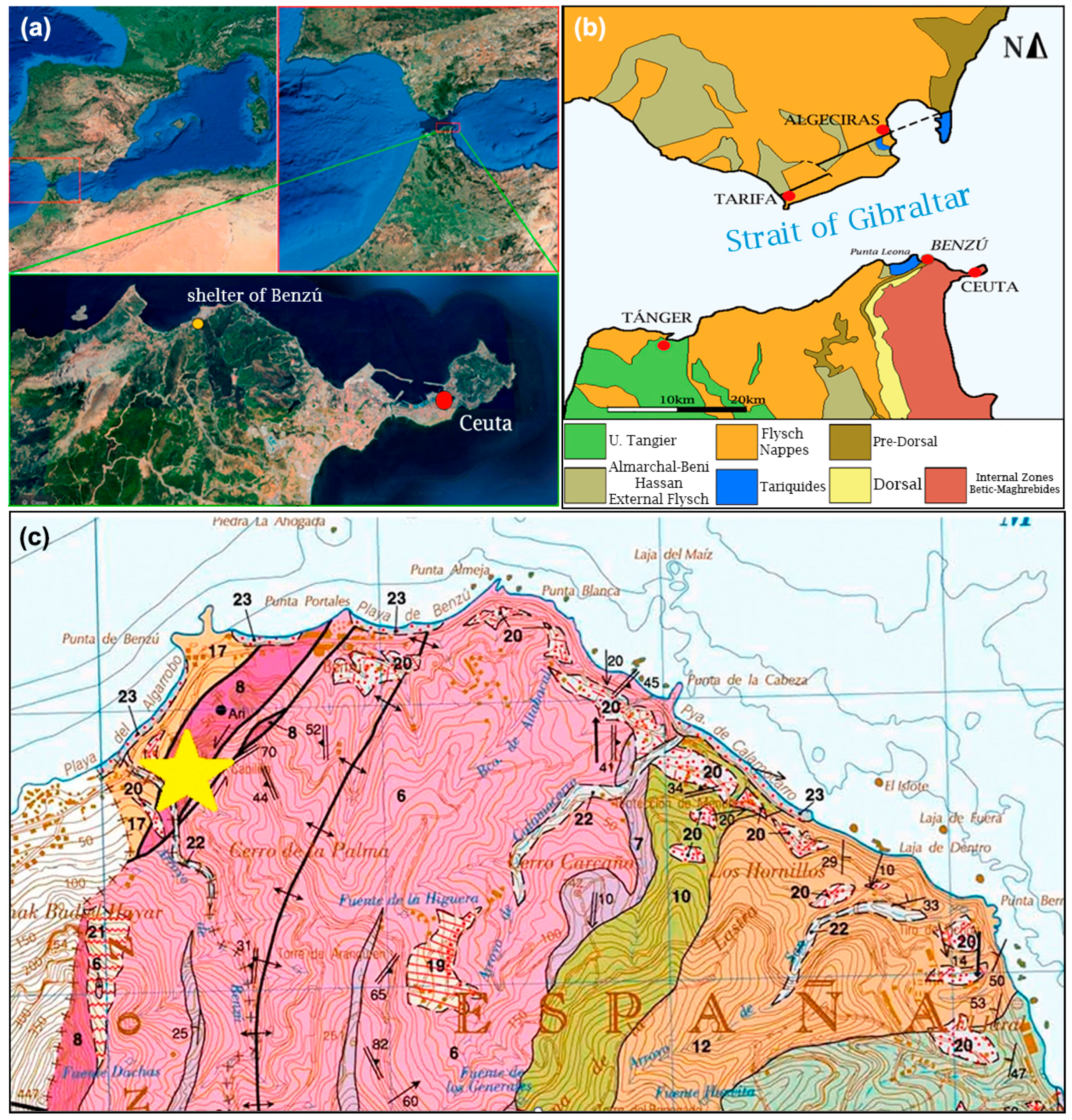

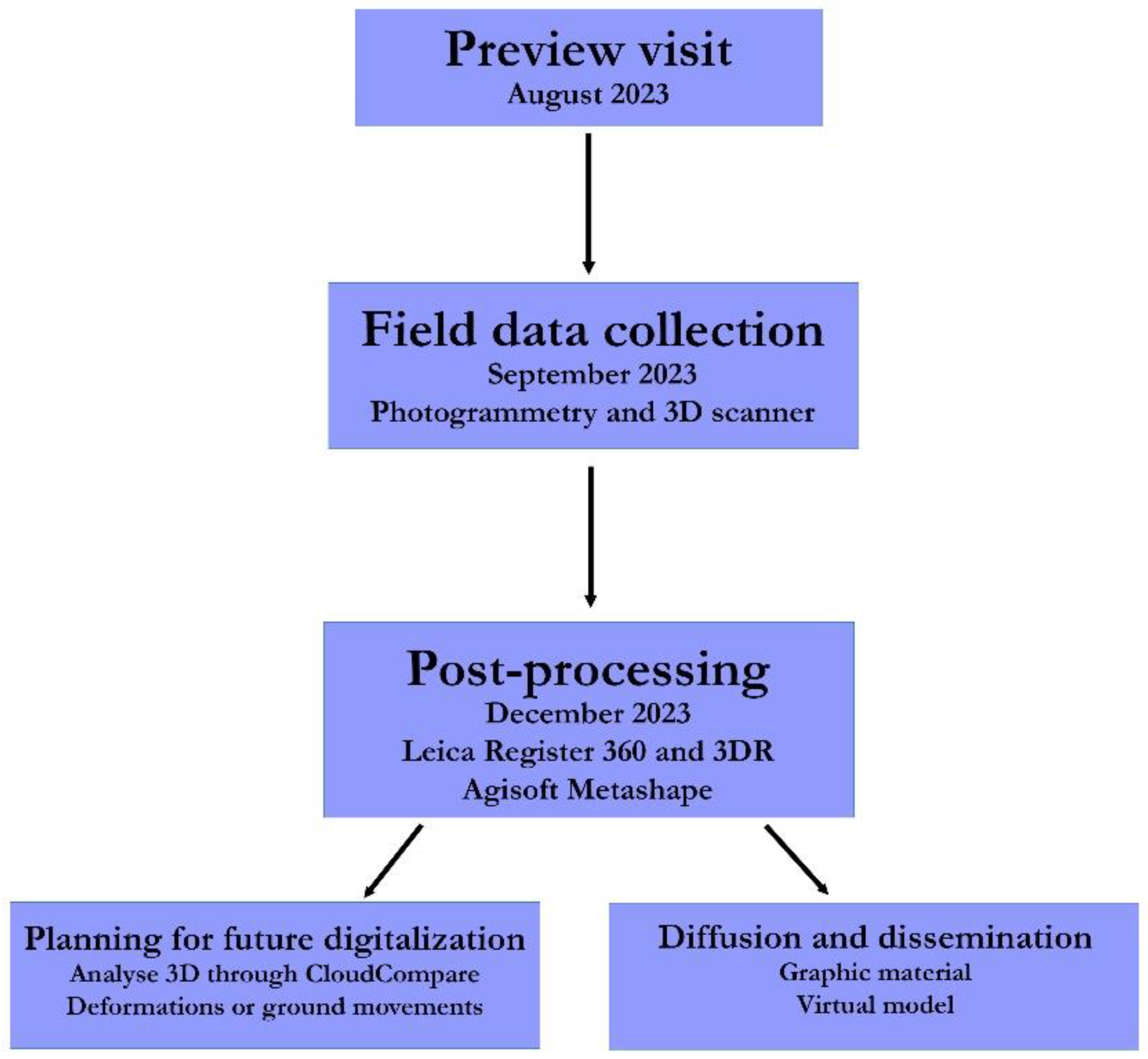
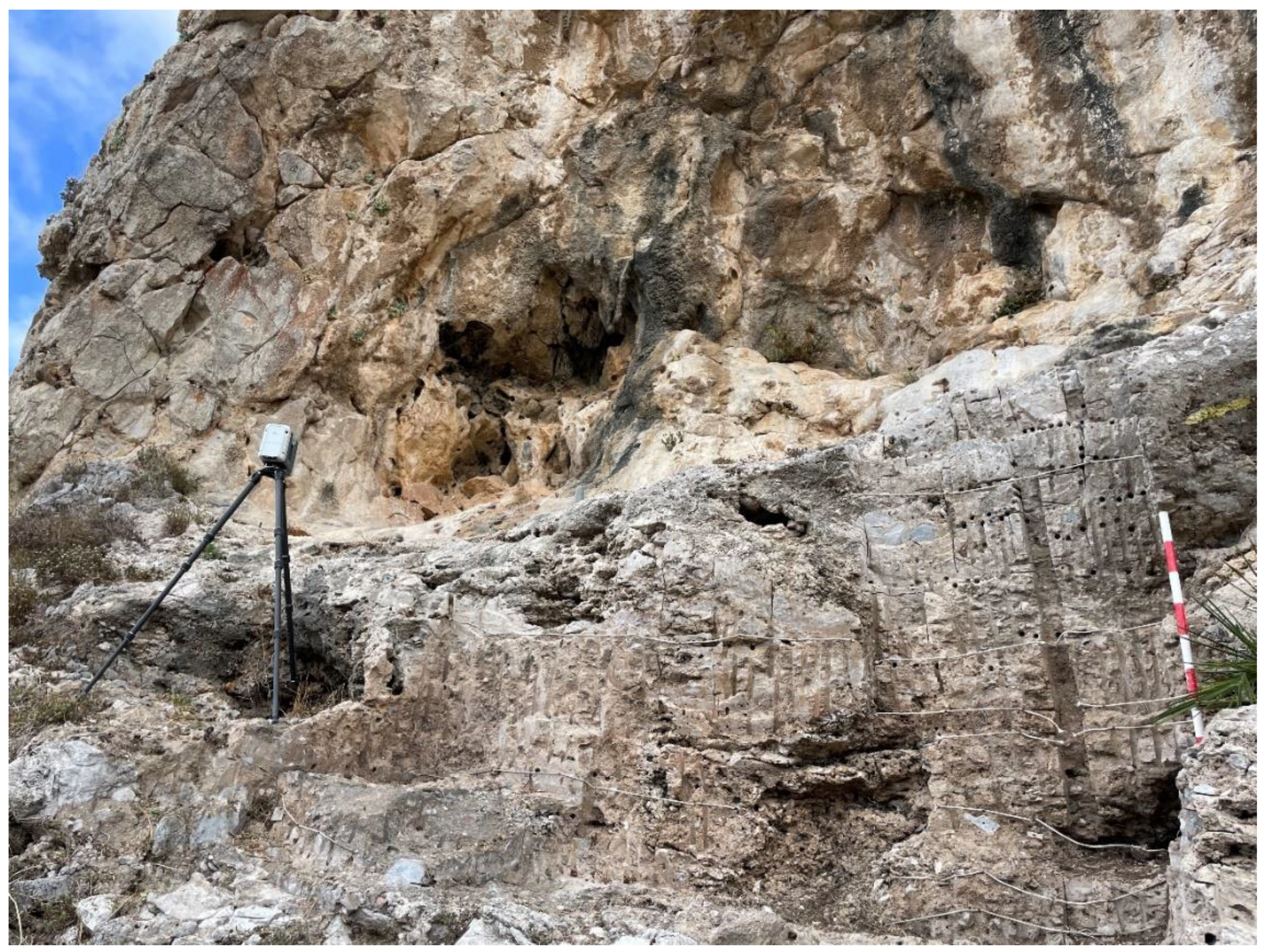
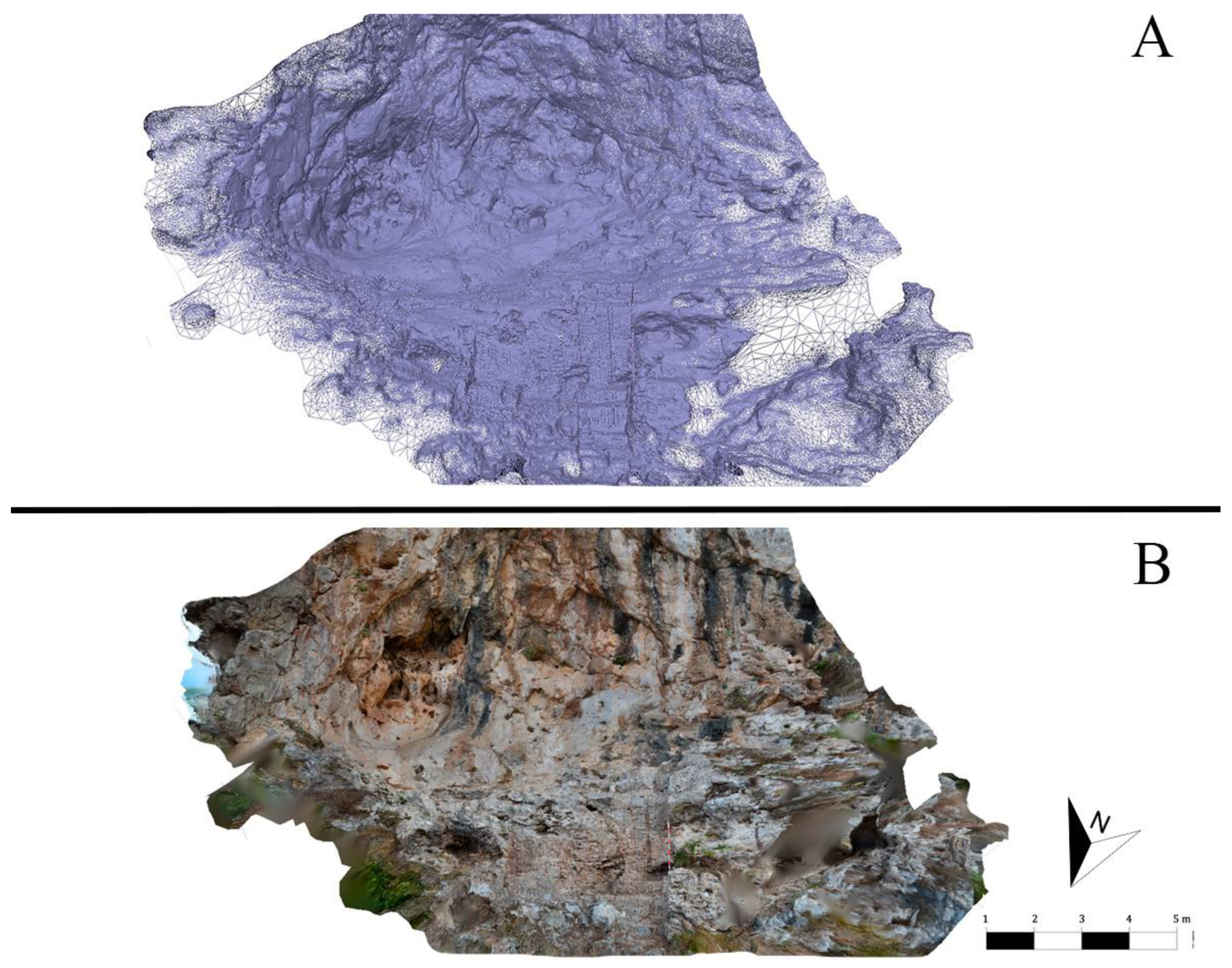
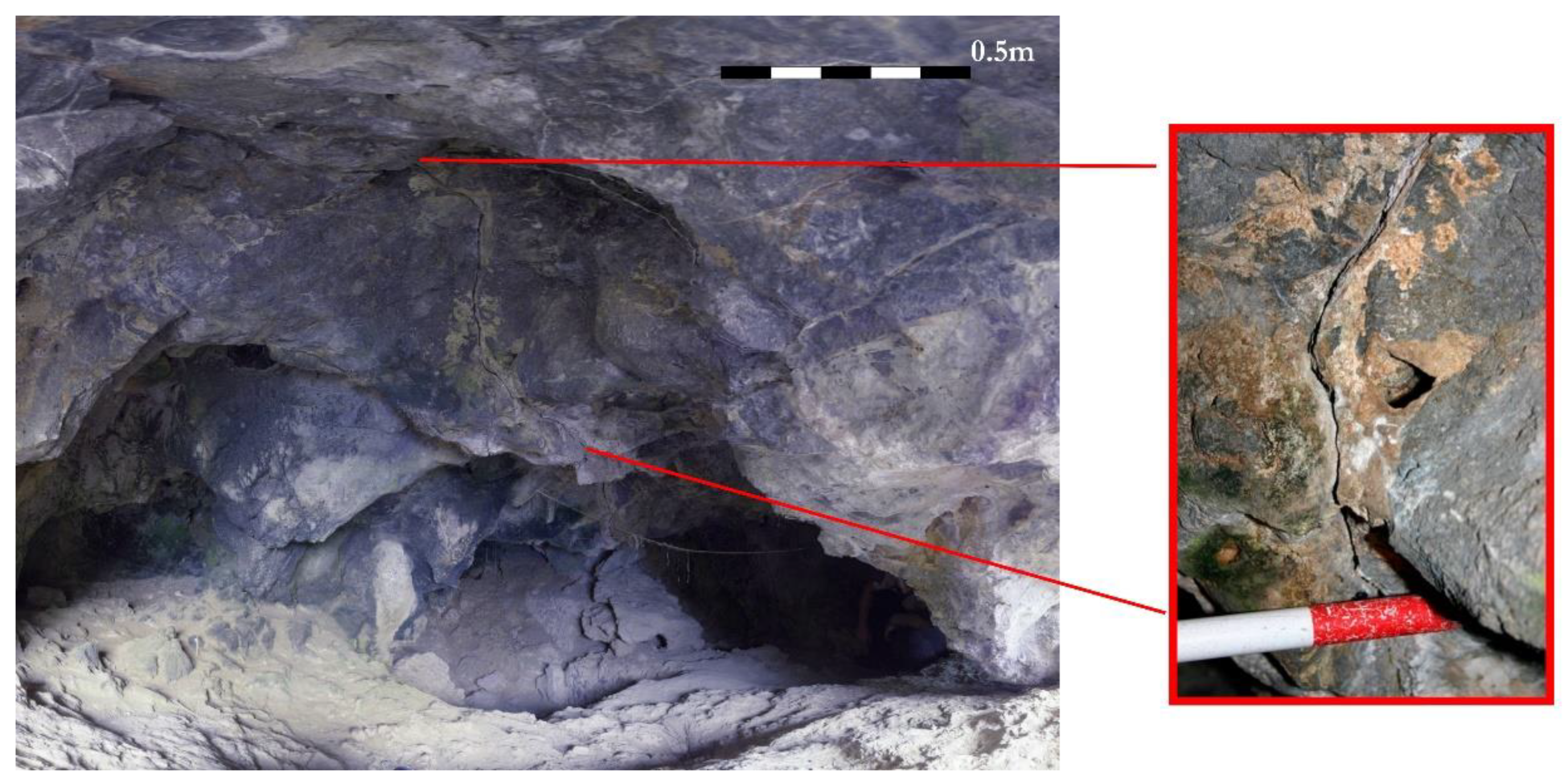

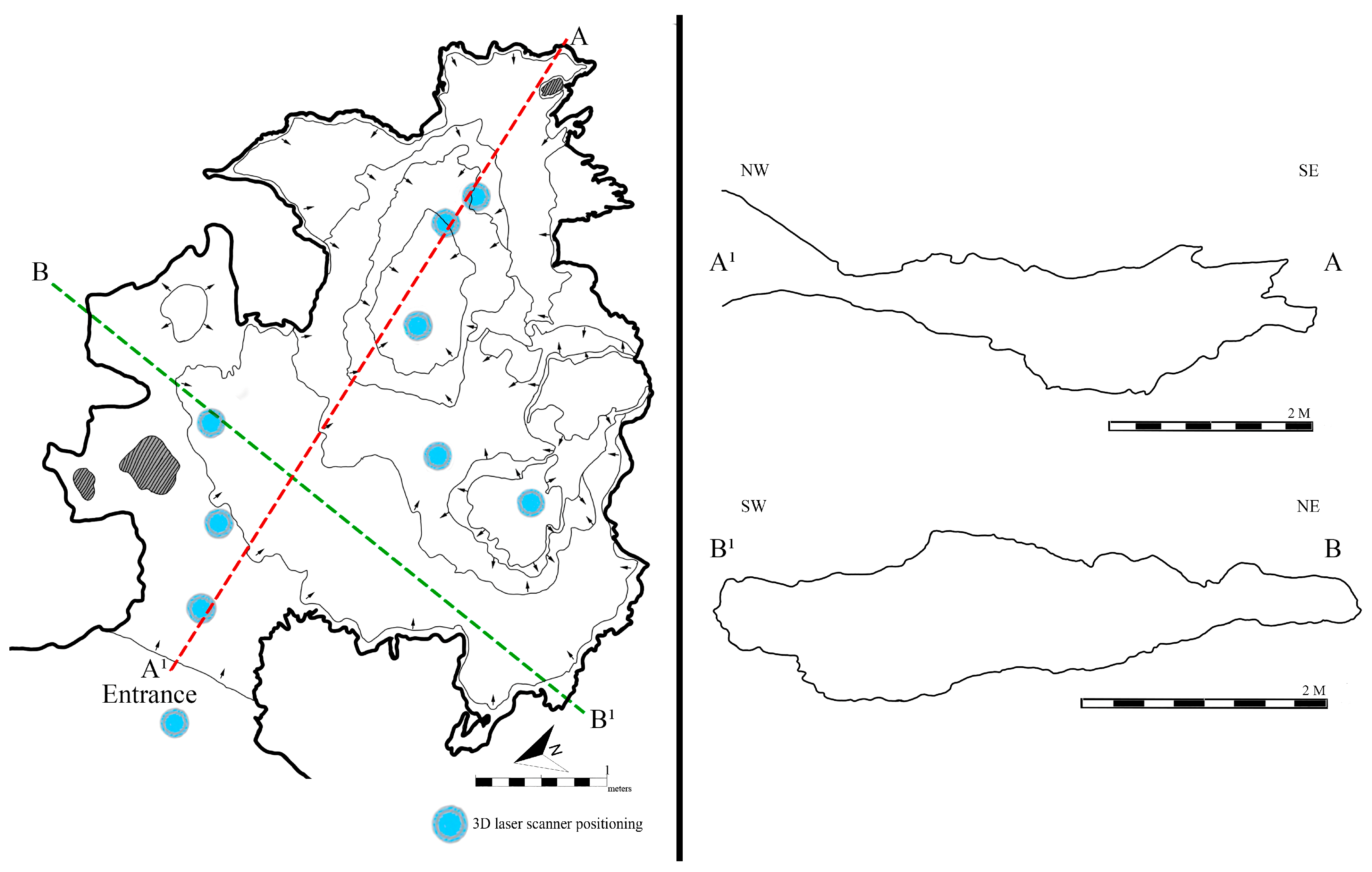
| Aspect | Traditional Methods | New Technologies |
|---|---|---|
| Written recording | Manuscripts, paper forms, and physical field journals | Use of mobile devices with digital forms and centralised databases |
| Archaeological drawing | Freehand sketches and drawings on graph paper | Digital drawing software based on 3D models |
| Photography | Analogue photography | Orthophotos generated from photogrammetry |
| Topography | Total stations with manual levelling | High-precision laser scanners and GNSS |
| 3D modelling | Manual modelling | Photogrammetry and laser scanning |
| Time and efficiency | Requires more time and personnel | Faster recording and automated processing |
| Precision and replicability | Greater margin for human error Difficult to replicate | High precision and replicability |
| Information preservation | Risk of loss or deterioration | Secure cloud-based digital storage |
| Accessibility and dissemination | Limited to physical reports or publications | Online data and virtual reality |
Disclaimer/Publisher’s Note: The statements, opinions and data contained in all publications are solely those of the individual author(s) and contributor(s) and not of MDPI and/or the editor(s). MDPI and/or the editor(s) disclaim responsibility for any injury to people or property resulting from any ideas, methods, instructions or products referred to in the content. |
© 2025 by the authors. Licensee MDPI, Basel, Switzerland. This article is an open access article distributed under the terms and conditions of the Creative Commons Attribution (CC BY) license (https://creativecommons.org/licenses/by/4.0/).
Share and Cite
Muñoz-Muñoz, A.; Ramos-Muñoz, J.; Vijande-Vila, E.; Cantillo-Duarte, J.J.; Ramírez-Amador, J.L.; Domínguez-Bella, S.; Becerra-Martín, S.; Molina-Piernas, E.; Fernández-Sánchez, D. Heritage in Danger: Digital Conservation and a Reserve for the Future of the Benzú Rock Shelter and Cave (Ceuta, Spain). Appl. Sci. 2025, 15, 5893. https://doi.org/10.3390/app15115893
Muñoz-Muñoz A, Ramos-Muñoz J, Vijande-Vila E, Cantillo-Duarte JJ, Ramírez-Amador JL, Domínguez-Bella S, Becerra-Martín S, Molina-Piernas E, Fernández-Sánchez D. Heritage in Danger: Digital Conservation and a Reserve for the Future of the Benzú Rock Shelter and Cave (Ceuta, Spain). Applied Sciences. 2025; 15(11):5893. https://doi.org/10.3390/app15115893
Chicago/Turabian StyleMuñoz-Muñoz, Alejandro, José Ramos-Muñoz, Eduardo Vijande-Vila, Juan Jesús Cantillo-Duarte, José Luis Ramírez-Amador, Salvador Domínguez-Bella, Serafín Becerra-Martín, Eduardo Molina-Piernas, and Diego Fernández-Sánchez. 2025. "Heritage in Danger: Digital Conservation and a Reserve for the Future of the Benzú Rock Shelter and Cave (Ceuta, Spain)" Applied Sciences 15, no. 11: 5893. https://doi.org/10.3390/app15115893
APA StyleMuñoz-Muñoz, A., Ramos-Muñoz, J., Vijande-Vila, E., Cantillo-Duarte, J. J., Ramírez-Amador, J. L., Domínguez-Bella, S., Becerra-Martín, S., Molina-Piernas, E., & Fernández-Sánchez, D. (2025). Heritage in Danger: Digital Conservation and a Reserve for the Future of the Benzú Rock Shelter and Cave (Ceuta, Spain). Applied Sciences, 15(11), 5893. https://doi.org/10.3390/app15115893









